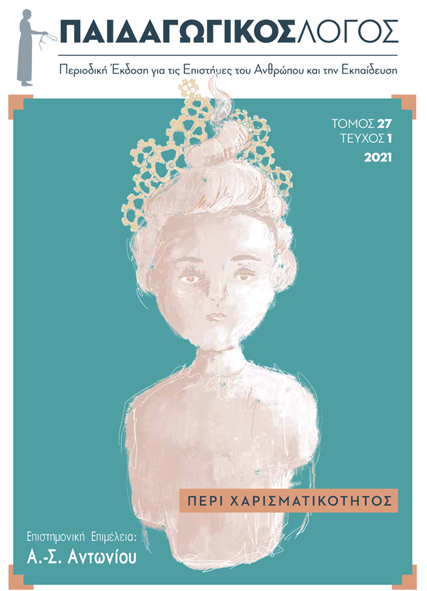Επίπεδα συναισθηματικής νοημοσύνης στα χαρισματικά παιδιά
Abstract
Σύμφωνα με τονGoleman, ησυναισθηματική νοημοσύνηπεριλαμβάνειχαρακτηριστικά,όπωςικανότητα κινητοποίησης του ατόμου, αντοχή απέναντιστα εμπόδια, ικανότητα ελέγχου των αντιδράσεων, ρύθμιση τηςδιάθεσηςπου εμποδίζειτην ικανότητασκέψης, αποφυγή τουστρες, ενσυναίσθηση, αισιοδοξία. Έρευνες έχουν δείξει πως η ευφυΐα και η συναισθηματική νοημοσύνη δεν είναι αντίθετες έννοιες αλλά συχνά συνυπάρχουν. Τα χαρισματικά παιδιά εμφανίζουν υψηλότερη απόδοση από ό,τι οι συμμαθητές τους ως προς το γνωστικό τους επίπεδο, τη δημιουργικότητα, τις τέχνες και την ηγετική συμπεριφορά. Όσον αφορά τα επίπεδα συναισθηματικής νοημοσύνης των χαρισματικών παιδιών, ευρήματα ερευνών έχουν δείξει σημαντικές διαφορές ως προς τους μέσους νοήμονες μαθητές, καθώς τα χαρισματικά παιδιά φαίνεται να έχουν μεγαλύτερη κοινωνική και συναισθηματική ωρίμαση, καλύτερη προσαρμογή και υψηλότερα επίπεδα συναισθηματικής νοημοσύνης. Πιο συγκεκριμένα, έρευνες έχουν βρει ότι υπάρχουν σημαντικές διαφορές μεταξύ των δύο προαναφερθέντων πληθυσμών στις υποκλίμακες της συναισθηματικής νοημοσύνης που αφορούν στην αυτό-συνείδηση, στη διαχείριση και κινητοποίηση των συναισθημάτων αλλά δεν βρέθηκαν διαφορές στις υποκλίμακες της ενσυναίσθησης και των κοινωνικών δεξιοτήτων. Από την άλλη πλευρά, όμως, υπάρχουν και ευρήματα που δεικνύουν πως δεν υπάρχουν σημαντικές διαφορές ως προς τη συναισθηματική νοημοσύνη μεταξύ των χαρισματικών παιδιών και των συνομηλίκων τους. Είναι ανάγκη, λοιπόν, να υπάρξει περαιτέρω έρευνα στην πληθυσμιακή ομάδα των χαρισματικών παιδιών.
Article Details
- Come citare
-
Πλούμπη Α., & Αντωνίου Α.-Σ. (2021). Επίπεδα συναισθηματικής νοημοσύνης στα χαρισματικά παιδιά. Παιδαγωγικός Λόγος, 27(1), 121–143. https://doi.org/10.12681/plogos.27925
- Fascicolo
- V. 27 N. 1 (2021): Περί Χαρισματικότητος
- Sezione
- Articles

Questo lavoro è fornito con la licenza Creative Commons Attribuzione - Non commerciale - Non opere derivate 4.0 Internazionale.
Οι Συγγραφείς που δημοσιεύουν εργασίες τους σε αυτό το περιοδικό συμφωνούν στους παρακάτω όρους:
- Οι Συγγραφείς διατηρούν τα Πνευματικά Δικαιώματα και χορηγούν στο περιοδικό το δικαίωμα της πρώτης δημοσίευσης, ενώ ταυτόχρονα τα πνευματικά δικαιώματα της εργασίας προστατεύονται σύμφωνα με την χρήση άδειας που υιοθετεί ο «Παιδαγωγικός Λόγος - Περιοδική Έκδοση για τις Επιστήμες του Ανθρώπου και την Εκπαίδευση» : Αναφορά Δημιουργού – Μη Εμπορική Χρήση – Όχι Παράγωγα Έργα 4.0 (CC BY-NC-ND). Αυτή η άδεια επιτρέπει στους άλλους να έχουν πρόσβαση στο έργο και να το μοιράζονται με άλλους, εφόσον κάνουν αναφορά σε αυτό, ωστόσο δεν μπορούν να το αλλάξουν με κανένα τρόπο ούτε να το χρησιμοποιούν για εμπορική χρήση.
- Οι συγγραφείς μπορούν να συνάπτουν ξεχωριστές και πρόσθετες συμβάσεις και συμφωνίες για τη μη αποκλειστική διανομή της εργασίας, όπως δημοσιεύτηκε στο περιοδικό αυτό (π.χ. κατάθεση σε ένα ακαδημαϊκό καταθετήριο ή δημοσίευση σε ένα βιβλίο), με την προϋπόθεση της αναγνώρισης και την αναφοράς της πρώτης δημοσίευσης σε αυτό το περιοδικό.
- Το περιοδικό επιτρέπει και ενθαρρύνει τους συγγραφείς να καταθέτουν τις εργασίες τους μέσω διαδικτύου (π.χ. σε ένα ακαδημαϊκό καταθετήριο ή στους προσωπικές τους ιστοσελίδες) πριν και μετά από τις διαδικασίες της δημοσίευσης, καθώς αυτό μπορεί να οδηγήσει σε παραγωγική ανταλλαγή ιδεών και σκέψεων, καθώς επίσης και σε γρηγορότερη και μεγαλύτερη χρήση και ευρετηρίαση της δημοσιευμένης εργασίας



